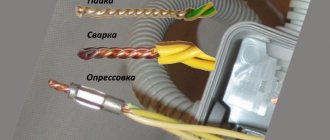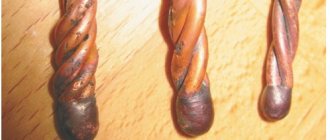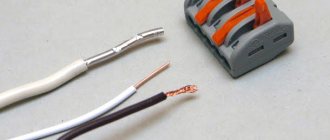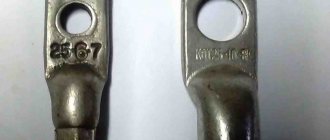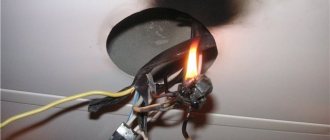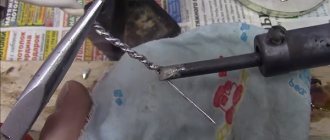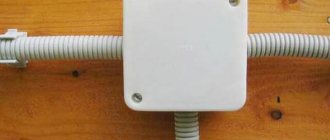When working with car electrical systems, for example, during repairs or additions to some device, you often have to deal with connecting wires. Usually, it is not possible to make the connection of contacts standard, and you have to resort to other methods. There are quite a few ways and each has its own advantages and disadvantages.
How to properly connect wires in a car
It is necessary to connect the wires in the car in case of repair (if there was a break), or when installing additional electrical equipment. We'll figure out how to properly connect wiring without a special tool with your own hands, how to make a branch from a wire, and also what methods should be avoided.
Several reliable ways to twist two wires
:
1.
Both wires are stripped to about 1-2 cm. We cross the wires at the place where the insulation ends. You need to twist it as tightly as possible to make good contact. Next we wrap the twisted end around one of the wires.
2.
We unravel the strands of the connected wires into two bundles each. We twist them in pairs, and then twist them together and bend them to the wire.
How to make a branch from a wire.
Using a knife, we strip 1-2 cm of the wire from which we need to make a branch. We also strip the wire that needs to be connected. Next, in the wire from which we are making a branch, we divide the wires into 2 pairs, making an eyelet into which we thread the connected wire. And then we do the twist.
Is it possible to solder?
When repairing electrical wiring, do not use soldering. This is stated in the VAG car repair manual:
How do you connect the wires in your car?
Key words: universal article
Source
The process of preparing veins for twisting
To twist electrical wires, you will need to de-energize the network by turning off the input circuit breaker. Next you will need:
- choose a tool with insulated handles and gloves made of dielectric material;
- remove the insulating coating from the conductors so that the metal part remains intact;
- soak a cloth in any degreaser (white spirit, acetone, nail polish remover) and wipe off the exposed parts;
- Use sandpaper to clean the area of the core so that it acquires a characteristic metallic sheen.
Twisting can begin only after preparation.
Pros and cons of twisting wires in a car
The easiest way to connect the wires is by twisting them. It's quick and doesn't require any tools other than a knife to strip the insulation layer. If necessary, twisted contacts are very easily broken without any tools.
The disadvantage of twisting is low reliability, as well as possible contact failure. This method increases the risk of oxidation, which can lead to unstable operation of the powered consumer.
Twisting in automotive electrics is not recommended for use in high current circuits. For example, to power headlights or connect fog lights. But it is quite suitable for low-current circuits. LED lighting may well consist of twisted connections.
A reliable twist is made by intertwining the fluffy ends into one whole. This ensures good contact between the two conductors.
Working with a multimeter
Voltage check
If some component in your car has failed (as you think), then you need to check for voltage in the circuit. To do this, switch the device to voltmeter mode, and then measure the voltage. To do this, install the positive probe on the positive of the battery, and the second on the terminal from the device. Thus, where the voltage shows, everything is in order, but where there is no reading, then there is a problem in this section of the circuit.
Before checking the wires, make sure that the battery is producing voltage, otherwise you may be looking for the cause in the wires, but the problem is a faulty battery.
Looking for a short circuit
Such a process during a short circuit is complicated at first glance, since it is notable for the fact that there is completely no voltage in the circuit.
What should be done:
- First of all, remove the fuse; it is removed from exactly the section of the circuit that will be tested.
- Switch the multimeter to a voltmeter.
- The probes are connected to the terminals, it is recommended to de-energize all other devices, this is done to prevent failures in other systems.
- Move the wire slightly and at this moment look at the readings, if they appear at some point and then disappear again, it means it is shorted.
Once problem areas are identified, they must be replaced. How to change the wiring in a car is a fairly simple question, and you shouldn’t have any difficulties. It is correct to do this together with the contact system, since if you use a piece of another wire and electrical tape, a new breakdown may appear.
Pros and cons of soldering wires in cars
In most electrical work, soldering can be a very reliable connection, but it is not recommended for use in cars. This is due to the fact that the soldered contact is susceptible to oxidation, which will provoke rapid destruction of the connection. A soldered connection has no flexibility and with minimal physical impact, contacts that have rotted will disintegrate.
It is not the soldering itself that deteriorates. The weak points of such a connection are located between the insulating layer of the wire and the soldering itself. Oxidation will occur here, which will provoke a breakdown.
Also among the negative aspects is the inconvenience of this method. Trying to solder contacts under the dashboard, where even primitive twisting cannot always be done properly, is very inconvenient.
A reliable soldered joint can be achieved by covering the twist with solder and covering the joint with a special varnish that will prevent oxidation.
Heat shrink or electrical tape
Remember that using electrical tape in the engine compartment is unsafe . Under the influence of temperature, it turns into “vines under the hood”, which can soon lead to a short circuit. Most insulating tape does not meet any quality standards and soon loses its properties even at room temperature. Therefore, I advise you to buy heat shrink, despite the fact that its cost is often less than electrical tape.
Pros and cons of welding wires in cars
Welding wires in a car is highly reliable and durable. In factory conditions, welding of contacts is used to create a reliable connection to the ground of the car, and some positive contacts are also combined together using welding. An undeniable advantage is that the welded joint has minimal resistance.
However, using it for repair purposes is very expensive and often inconvenient.
Checking reliability
It should be noted that fixation on PPE is very similar to conventional twisting, but with one difference - the presence of an insulating cap on it. So if the torsional strength is not much different. For better conductivity, simply strip the connected wires.
Let's see how long a “forbidden” connection can resist breaking.
The test ended at more than 6 kg, as the thread was attached to the steelyard and the knot (not twisted) began to unravel.
Withstands more than 62 kN
Now all that remains is to securely insulate the seam with electrical tape or heat-shrink insulation. You can use this.
If you clean the contacts well and insulate them reliably, such a simple connection will last for years, for which there is a lot of evidence.
The reason for the twist ban is anyone's guess: it appears to be a commercial advantage for manufacturers of PPE, Vago connectors and screw terminals, two of which are prone to melting and causing fires.
Pros and cons of crimping wires in a car
All car manufacturers recommend using crimping when repairing electrical systems. This is a popular method that has many advantages:
The only disadvantage we can highlight is that you have to buy a special tool - a crimper. Despite the fact that some couplings have polymer insulation, it is recommended to supplement the connection with heat shrinkage.
At the end of the topic, it is worth recalling that regardless of the chosen method, it is important to follow safety precautions when working with car electrical wiring. When making repairs, be sure to disconnect the battery. All positive contacts must have reliable insulation. Otherwise, a short circuit may occur, causing a fire.
Source
Terminal blocks
The terminal block is a contact plate in a polymer or carbolite housing. With their help, any user can connect the wires. Connection occurs in several stages:
- stripping of insulation 5-7 mm;
- removal of oxide film;
- installing conductors in sockets facing each other;
- bolting.
Pros: you can connect cables of different diameters. Disadvantages: you can only connect 2 wires.
Types of terminal blocks for multi-core and single-core cables
There are 5 main types of terminal blocks:
- knife and pin;
- life;
- locking and self-locking;
- hood;
- “walnut” type terminals.”
The first type is rarely used; they are not designed for high currents and have an open design. Screw terminals provide reliable contact but are not suitable for connecting multi-core cables.
Interlocking terminal blocks are the most convenient devices to use and do not require special equipment for installation. Caps are also used frequently, but unlike locking devices, caps can be used multiple times. "Nut" is practically not used.
Terminals in junction box (copper or metal)
Terminals are the most common connection method in a junction box. They are inexpensive, easy to install, provide a reliable contact seal and can be used to join copper and aluminum. Cracking:
- cheap, low quality household appliances;
- only 2 wires can be connected;
- not suitable for multi-core wires.
LizarD71 › Blog › Connecting wires in a car: soldering, twisting, crimping?
This question visits, perhaps, everyone who for the first time is faced with the task of independently equipping their pet with all sorts of things useful for the car. I was no exception, and before my playful hands climbed into a fresh product of the German automobile industry, I decided to thoroughly prepare, so as not to bite my elbows later. Primary requirements
I would define the following as connections: - physical strength;
— electrical reliability (low resistance); - in many cases, tightness. Let's look at the main options in order: Soldering
The main problem here is the active oxidation of the compound under outdoor conditions, which ultimately leads to the destruction of the joint. Of course, you can protect the connection, but in this case the time and effort will be unreasonably large. In addition, the VAG concern officially prohibits the use of soldering during repairs. In the image below: 1. Official ElsaWin repair manual for VAG group cars 2. Self-development program for mechanics of cars of the same VAG group SSP-91 3. Instructions for the service department for installing additional electrical accessories TPI 2028026
Appendix 1
: In comments, many defend soldering as a type of connection.
I have to clarify: I am not against this connection. If done correctly, it will most likely outlast the car. BUT
- not everyone has enough knowledge and experience for this! And for an experienced person, dancing with a soldering iron under a torpedo is a very dubious pleasure. That is why I do not recommend this method to readers.
Addendum 2
: If you are confident in your abilities and intend to use soldering, then here is a recipe from FirstHant:
If you need a high-quality, reliable and long-term connection - we strip the wires and twist them correctly - we solder them with high quality.
(12 volt soldering irons are not uncommon, as are 12-220 converters) - remove the remaining flux - coat the connection with a special polyurethane or zapon varnish - tighten it with heat shrink - fix the connection on both sides Addition
: In the comments, FirstHant perfectly described the process of making the correct twist:
if done correctly, strip it a couple of centimeters, cross the wires, departing 5 mm from the insulation, and wind the stripped end tightly, turn to turn, onto another wire, i.e.
from the place of “crossing” to isolation. Such twisting is mechanically strong, it is impossible to stretch it - only to break the wire. The wires must be made of the same metals. To protect against oxidation, you can lubricate with thick lubricant, without fanaticism. It is better to clean it with a special device, such as this one www.chipdip.ru/product/ht-766-tl-766/. The compression force is adjustable depending on the strength of the insulation. External connections cannot be protected with electrical tape! Moisture collects under it, does not drain well, and the connection quickly collapses. Crimping
Important note:
almost all manufacturers recommend crimping as the main method of connecting wires during repairs, including the VAG group (using original couplings - more about them below).
Pros:
- ease of connection;
— physical strength of the connection; — when using special couplings — insulation + sealing in one action without the use of additional materials. Cons:
— the original wire will have to be cut; - you need a crimper - a specific (albeit not very expensive) tool; - although the original couplings are very good, they are expensive - a price per piece +/- (fortunately, now there are analogues). I would also include piercing branch clamps in this category. More on them later.
For a long time it was a mystery to me how the connections of several wires inside a harness were made normally. The connection looks like this:
And recently I came across a video of how it works:
One way or another, it is obvious that repeating such a connection “on the knee” will not work, so we continue.
The process of connecting wires by crimping
Couplings are used for connection. Here they are:
Addendum 0:
To connect to the wiring, there is another method that allows you to completely maintain the original wiring, but requires a tool. It will be described at the end of the article.
Addendum 1:
I was surprised to discover that there are analogues from Bosch, and much cheaper than VAG!
Bosch 1 987 532 035
- 0.5-1.0mm Bosch
1 987 532 000
- 0.5-1.5mm Bosch
1 987 532 001
- 1.5-2.5mm Bosch
1 987 532 002
- 4.0-6 .0mm
Addendum 2:
Not long ago, our Chinese friends learned to do similar things. You can order it, for example, here. The price tag is not very Chinese, but several times cheaper than the original. There is a little less sealant inside than in the original, but overall they work as they should. Must have)
Source
Isolate the connection
There are two main ways to insulate connections - electrical tape and heat shrink tubing.
- Insulating tape has no rivals in terms of versatility, availability and ease of use. There are two main types of electrical tape: PVC and CBD. Polyvinyl chloride tape looks elegant, it is resistant to moisture, and can withstand voltages of several thousand volts. There are also disadvantages: PVC is not heat-resistant, and therefore its use under the hood is limited. In the cold, such tape breaks and loses its adhesive properties. As for cotton tape, it is not damaged by frost, can withstand heat and is highly wear-resistant. Disadvantage: poor sealing.
INSULATING TAPE
Due to the fact that in the USSR the most common color of PVC electrical tape was blue, many humorous sayings appeared, reflecting its widespread use in everyday life.
“There’s nothing more permanent than something temporarily wrapped in blue tape.”
“You can do anything with straight arms and blue tape.”
- Heat-shrinkable tubes are beautiful and modern, but most likely you won’t find them in a car owner’s luggage. Let us remember that when heated, such a tube noticeably contracts, reliably protecting the connection. Heat shrink with an adhesive layer (the name usually contains the symbol G (from Glue - “glue”) is stronger than usual. After heating, the glue protects the joints well from moisture. When using regular heat shrink, a sealant can be used for waterproofing. The heat shrink tube reduces its diameter when heated by 2 –2.5 times To guarantee tight compression, it is better to take a factor of 2.
When connecting to a wire without breaking it, it will not be possible to apply heat shrink - only electrical tape will help.
What is the best way to reliably connect two cables together?
Methods of connecting cables that require equipment and skills in the field of electrical engineering:
- soldering;
- welding;
- crimping with sleeves.
Simple connection methods that do not require tools or knowledge:
- connection using terminal blocks;
- spring clamps;
- PPE caps;
- bolted connection.
The choice of connection method depends on the characteristics of the wires. It is necessary to take into account the type and material of the core, the number of wires, and operating conditions.
Aluminum
Aluminum wires can also be connected using any method, but with some special features. When connecting, the metal must be manually stripped of insulation.
Copper and aluminum wires cannot be connected directly. The connection point becomes very hot and over time the contact weakens. Therefore, it is better to use terminal blocks, wago, bolt connection or special branch clamps.
Copper
Copper wire can be connected using terminal blocks, Wago clamps (necessarily using special paste), using a bolt, or soldering.
